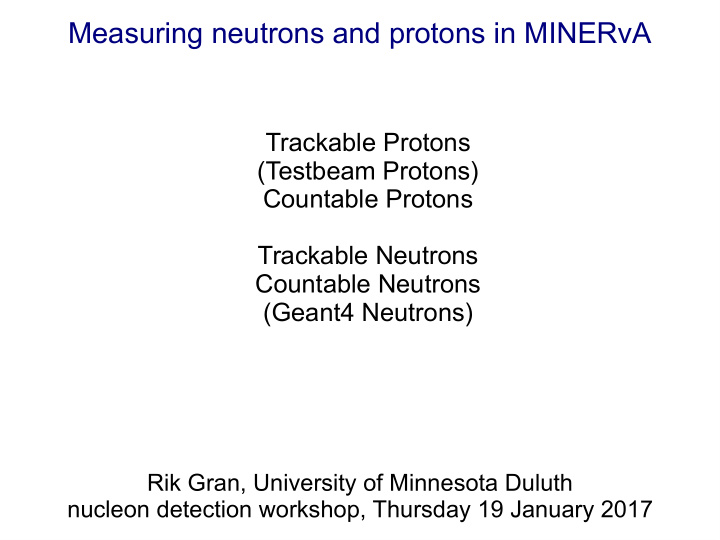



Measuring neutrons and protons in MINERvA Trackable Protons (Testbeam Protons) Countable Protons Trackable Neutrons Countable Neutrons (Geant4 Neutrons) Rik Gran, University of Minnesota Duluth nucleon detection workshop, Thursday 19 January 2017
Trackable protons CCQE candidate in passive target 5 (then proton interacts making a neutron) CCQE candidate in tracker Usually required to go at least five planes (full UXVX set plus one) Gives us a confident direction, energy from range or calorimetry. Can separate stopping protons from pions and not-stopping protons with dE/dx profile and the characteristic Bragg peak Can separate pi+ (and mu+ and some mu-) with Michel electron tag
Trackable protons can be low background dE/dx(MeV/mm) dE/dx profile with characteristic Bragg peak CH Good separation from pions, not-stopping protons with dE/dx profile Can separate pi+ (and mu+ and some mu-) with Michel electron tag
Testbeam measurements Proton with KE = 220 MeV stopping in tracker from test beam data. characteristic Bragg peak ends with a strip > 20 MeV Five plane tracking threshold means protons with ~100 MeV KE (~450 = p) if at normal incidence stopping proton (they are not for neutrino data) range “calibration” KE from range or calorimetry We measure proton energy calorimetrically below five planes and tag the 20 MeV Bragg peak
One of many analysis examples for protons Choose two-track sample mu + proton (no other particles) get Q2 from proton only [and M' = M n + ϵ B ] Lead Iron Followup from PRD 91 (2015) 071301, T. Walton but now in passive iron and lead targets (JETP 7 Oct 2016) M. Betancourt Or this is the ~KE distribution: Q2 = 0.2, Tp = 0.1 GeV; Q2 = 1.0, Tp = 0.55 GeV
Countable protons in inclusive sample We see protons that are too low energy to track. Always include their energy calorimetrically in the hadron system Can count them by counting Bragg peaks (hits > 20 MeV) Evidence the data need more low-energy multi-proton events, such as provided by a 2p2h model. Error band dominated by Birks scintillator response constraint
And now for something completely different... neutrons!
Trackable neutrons Tejin Cai If the cluster has hits in at least two views, we have 3D position and with the vertex location can get the angle. Visible ~30% of the time for higher energy neutrons. (But little or no reliable total neutron energy information and sometimes the neutron has an unnoticed soft scatter.)
Trackable neutrons, example analysis with angles How far out of the neutrino-muon plane (radians) Tejin Cai coplanarity angle θc (radians) With no nuclear effects, MC predicted peak for antineutrino CCQE on Hydrogen (Red) is narrower than on Carbon a measurement opportunity
Countable neutrons From Miranda Elkins One neutron with 50 < KE < 100 MeV MC predicted detection efficiency ranges from 5% KE < 10 MeV 30% 10 < KE < 50 45% 50 MeV < KE countable neutron candidates are as small as a single cluster noise in LE beam encouragingly low for single cluster, can get Z-position relative to vertex, not 3D Trying an application of neutron counting (and n+p counting) as mark of multi-nucleon ejection process similar to the proton counting strategy in the neutrino case
Geant4 neutron simulation Geant 4.9.X benchmark studies by Juan Pablo Velasquez, Aaron Mislivec Gonzalo Diaz, Leo Aliaga, Steve Dytman neutron carbon inelastic cross section 60 125 kinetic energy (MeV) Total inelastic cross section uncertain by 10% for C (15% for Fe, 20% for Pb) Elastic cross section is not well reproduced use uncertainties of neutron carbon elastic cross section 20% C, 40% Fe, 60% Pb 60 300 600 kinetic energy (MeV)
Geant4 neutron simulation We have some uncertainty estimates and reweights that mimic alternate cross sections and are a standard part of MINERvA systematics studies. but may need to consider “fates” of neutron reinteractions Have found issues with details of the Geant4 v.9 simulation artifacts visible in our MC not in data that required workarounds. Some current analyses in MINERvA may be more sensitive to these issues than previous ones, and additional simulation studies are being considered.
Conclusions Lots of experience with protons above ~100 MeV tracking threshold. Have always included protons in calorimetry even if they were not trackable (too short, or reinteract in the detector and confuse tracking) Excellent test beam data constrain uncertainties. Some new methods to count protons, even down to ~30 MeV. Having some new success with variations of all of these for neutrons we find they are 30 to 50% detectable for healthy neutron energies depending on threshold, strategy
Backup
Proton and Neutron counting algorithm more detail Proton “counting” Count single scintillator strips over 20 MeV restricted to a box near the vertex. For the kinematics of the analysis where we use this, the box serves as a simple pion rejection. Pions at those energies will usually leave the box, protons won't. Isn't so simple for higher momentum transfer. Neutron “counting” candidate is isolated activity, as little as a single strip. Isolated means its not part of the activity around the vertex using our “filament” blobber, with a gap tolerance to connect adjacent energy deposits without literally tracking them. and not too close to the muon (suppresses brem/knock-on activity) If activity is found nearby in the same plane or nearby planes (few strips or modules) treat it as the same single candidate.
Recommend
More recommend